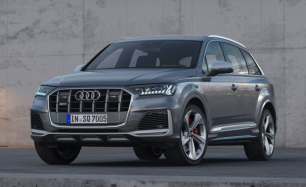Measuring 5243mm, 2030mm wide and 1782mm tall with a 3135mm wheelbase, the GLS63 is an upper-large SUV in every sense of the term, which means it’s also very practical.
For example, cargo capacity below the load cover is decent, at 355L, but stow the 50/50 power-split-folding third row via the boot and it’s very good, at 890L, or drop the 40/20/40 power-split-folding middle bench, too, and it becomes a cavernous 2400L.
Better yet, the boot’s aperture is almost square, and its floor’s flat, while there’s no load lip to contend with, making loading bulkier items even easier. Up to four tie-down points are also on hand (depending on seating configuration) to secure loose cargo.
Under the false floor is the space-saver spare, which is to be expected, but what isn’t expected necessarily is the fact there’s also enough room there for the cargo cover when it’s not in use, which would be the case if six or more passengers are regularly onboard.
Moving into the power-sliding second row, the GLS63’s practicality is once again brought to the fore, with up to six-plus inches of legroom available behind my 184cm driving position.
There’s also two inches of headroom with the panoramic sunroof in situ, not to mention just enough toe-room. The GLS63’s small transmission tunnel and sheer width also mean three adults can be seated on the middle bench with few complaints.
Amenities-wise, the second row has map pockets on the front-seat backrest and a small fold-down cubby below the rear climate controls, with it containing two slots for smartphones and a pair of strategically placed USB-C ports.
The rear door bins can take one large bottle each, while a fold-down central armrest is also on hand, featuring a shallow tray and retractable (and flimsy) cupholders.
Alternatively, the $2800 Rear Seat Comfort Package fitted to our test vehicle subs in a tablet that can control the multimedia system, a wireless smartphone charger and a small cubby into the former, as well as a heated/cooled cupholder atop the rear of the centre console.
In the third row, it’s not quite as roomy if you’re an adult. With the middle bench in its most accommodating position, my knees still brush up against its backrest, which is to be expected given it’s primarily designed for children. I also have an inch of headroom there.
Nonetheless, getting in and out of the third row is relatively easy as the power-operated middle bench tumbles forward and provides just enough space to make entry and exit somewhat graceful.
When seated, rear occupants are treated to two USB-C ports and one small cupholder each, so they’re arguably taken better care of than those in the middle.
Child seats are well and truly accommodated, with four ISOFIX and five top-tether anchorage points fitted across the second and third rows, although the latter will inevitably prove to be a much tighter fit.
The driver and front passenger are still taken care of, with a front cubby taken up by two heated/cooled cupholders, a wireless smartphone charger, two USB-C ports and a 12V power outlet, while their door bins take one large and one small bottle each.
In-cabin storage options include the large central storage bin, which hides another USB-C port, while the glovebox is on the smaller side, with about a third of it taken up by the fragrance, which is pumped into the cabin to ensure the interior always smells its best.

















































